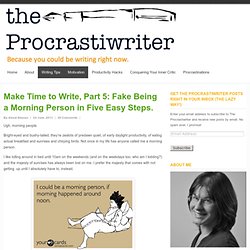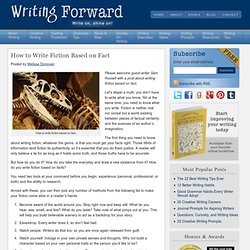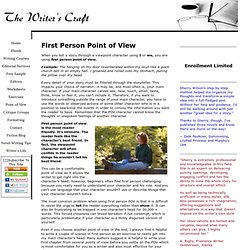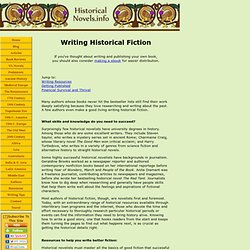

Make Time to Write, Part 5: Fake Being a Morning Person in Five Easy Steps. Ugh, morning people.

Bright-eyed and bushy-tailed, they’re zealots of predawn quiet, of early daylight productivity, of eating actual breakfast and sunrises and chirping birds. Not once in my life has anyone called me a morning person. I like lolling around in bed until 10am on the weekends (and on the weekdays too; who am I kidding?) And the majesty of sunrises has always been lost on me. I prefer the majesty that comes with not getting up until I absolutely have to, instead. The Five Rules of Writing Flashbacks. Tips for effectively writing flashbacks into your scenes.

How to Write Fiction Based on Fact. How to write fiction based on fact.

Please welcome guest writer Sam Russell with a post about writing fiction based on fact. Let’s dispel a myth: you don’t have to write what you know. Yet at the same time, you need to know what you write. Fiction is neither real nor unreal but a world existing between places of factual certainty and the avenues of an author’s imagination. The first thing you need to know about writing fiction, whatever the genre, is that you must get your facts right. But how do you do it? You need two tools at your command before you begin: experience (personal, professional, or both) and the ability to research. Omniscient Person Point of View — The Writer’s Craft. Basically, omniscient point of view means that the story is told from an all-seeing God-like, omnipotent viewpoint.

You would use third person pronouns in the writing, but you can choose to dip into the head of any of the characters and reveal things that have occurred in the past or will happen in the future. This was once a very popular method of storytelling. It is less so now, especially in the North American market. First Person Point of View — The Writer’s Craft. When you tell a story through a viewpoint character using I or we, you are using first person point of view.

Example: The banging on my door reverberated within my skull like a giant church bell in an empty hall. I groaned and rolled onto my stomach, pulling the pillow over my head. Every detail of your story must be filtered through the storyteller. This impacts your choice of narrator—it may be, and most often is, your main character. If your main character cannot see, hear, touch, smell, taste, think, know or feel it, you can’t include it. How to Build a Stockpile of Good Writing Ideas. Returning to old scraps of writing is one of the best ways to cure writer’s block Not every idea that strikes is going to immediately turn into the beginnings of a novel, story, or poem; sometimes an idea is just a lonely little thing that lives underground for 17 years before… oh wait, that’s the cicada.

But not unlike those weird little bugs, ideas can take a long while to come of age. You never know when something you thought up months or years ago will fit itself perfectly — almost accidentally — into your latest work-in-progress, or rub against another idea and spark. That’s why it’s important to write everything down: the brilliant lines, the half-baked notions, and that nonsense you scribbled on a sticky-note after a dream. Gather the seeds. How to Edit Your Own Writing.
How to Write a Story: Creative Story Ideas, Tips to Help You Write Your Own Book. Get creative story ideas, write your own book!

02 Know How to Write Well. 3 Ways to Know When to End Your Chapters. At some point in writing your novel, you have to start thinking about “chaptering,” the process of deciding exactly when and where your chapter breaks will go.

This is one issue for which you should not turn to the classics for help. In the days of Dickens and Tolstoy, the first few pages of each chapter served to get the reader ready for the events to come. Have you ever been to an elaborate theatrical production during which the curtain remains up through intermissions so you can see the workers shifting and turning the huge sets on their groaning sleds and rollers?
That’s what I’m reminded of when I start a chapter by Melville or Hugo. Nowadays readers have less patience, and the novelistic curtain stays down during intermission as the reader leaps from chapter to chapter without being aware of all the whirring gears and pulleys we have so adroitly hidden from view. Thoughtful chaptering is more important than ever. Writing Historical Fiction. If you've thought about writing and publishing your own book, you should also consider making a ebook for easier distribution.

Jump to:Writing ResourcesGetting PublishedFinancial Survival and Thrival Many authors whose books never hit the bestseller lists still find their work deeply satisfying because they love researching and writing about the past. How to Plan, Write, and Develop a Book. So You Want to Write a Book in Word. Ten rules for writing fiction. Elmore Leonard: Using adverbs is a mortal sin 1 Never open a book with weather.

If it's only to create atmosphere, and not a character's reaction to the weather, you don't want to go on too long. The reader is apt to leaf ahead looking for people. There are exceptions.